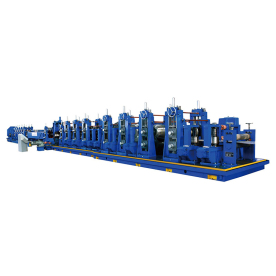In today’s fast-paced industrial landscape, the demand for efficient and high-quality pipe production has reached unprecedented levels. Industries ranging from construction to oil and gas rely heavily on pipes for various applications, making the role of high-speed pipe making machinery crucial in meeting these demands. This article will explore the benefits, technological advancements, and applications of high-speed pipe making machinery, highlighting its significance in modern manufacturing.

Revolutionizing Industry with High-Speed Pipe Making Machinery: Enhancing Production Efficiency and Quality
High-speed pipe making machinery refers to specialized equipment designed to produce pipes at an accelerated rate while maintaining or improving quality. These machines utilize advanced technology and innovative designs to streamline the manufacturing process, resulting in pipes that meet stringent industry standards. The capabilities of these machines are particularly important in a world where time is money, and operational efficiency can make a significant difference to a company’s bottom line.
One of the primary advantages of high-speed pipe making machinery is its ability to dramatically increase production output. Traditional pipe manufacturing methods often involve lengthy processes that limit the number of pipes produced in a given time frame. In contrast, high-speed machinery can produce pipes at rates previously thought impossible—often significantly reducing production cycles. This increase in speed does not compromise the quality of the pipes, as these machines are engineered to handle materials with precision, ensuring that each pipe meets the required specifications.
Technological advancements in high-speed pipe making machinery have also played a significant role in enhancing production efficiency. Modern machines are equipped with features such as automated feeding systems, real-time monitoring, and advanced computer controls. These innovations not only facilitate a smoother production process but also reduce the chances of human error, thereby ensuring greater consistency in product quality. Additionally, many machines now incorporate energy-efficient technologies that contribute to sustainability goals by reducing power consumption during manufacturing.

Revolutionizing Industry with High-Speed Pipe Making Machinery: Enhancing Production Efficiency and Quality
Another critical aspect of high-speed pipe making machinery is its versatility. These machines can typically work with a variety of materials, including steel, PVC, fiberglass, and more. This adaptability allows manufacturers to cater to a diverse range of markets and applications. For example, industries such as plumbing, HVAC (heating, ventilation, and air conditioning), and telecommunications often require different types of pipes, and a single high-speed pipe making machine can effectively produce all these varieties. As market demands shift, manufacturers equipped with versatile machinery stand a better chance of remaining competitive.
Furthermore, the applications of high-speed pipe making machinery extend beyond mere production. The efficiency and speed at which pipes can be manufactured can significantly affect project timelines in construction and infrastructure development. For instance, in the oil and gas sector, where pipelines are crucial for transporting resources over long distances, the ability to produce pipes rapidly can impact project costs and delivery schedules. In this way, high-speed pipe making machinery is not just about production; it’s about enhancing the overall supply chain.
Despite the clear benefits of high-speed pipe making machinery, it is essential for manufacturers to consider the capital investment involved in acquiring such advanced equipment. However, it’s important to view this investment as a long-term strategy. The increased productivity, reduced labor costs, and improved quality control can lead to significant returns over time. Businesses that invest in high-speed machinery often find that they gain a competitive edge, positioning themselves as leaders in their respective industries.

Revolutionizing Industry with High-Speed Pipe Making Machinery: Enhancing Production Efficiency and Quality
In conclusion, high-speed pipe making machinery represents a significant leap forward in manufacturing technology. By enhancing production efficiency, maintaining quality, and allowing for versatile applications, these machines have become vital for industries that rely heavily on pipe production. As technology continues to advance, it is likely that we will see even greater innovations in this field, contributing to a more efficient and sustainable industrial landscape. Therefore, industries looking to optimize their manufacturing processes should consider the adoption of high-speed pipe making machinery to stay ahead in an increasingly competitive market.Automatic Tube making machine


